Fighter Seversky R-35
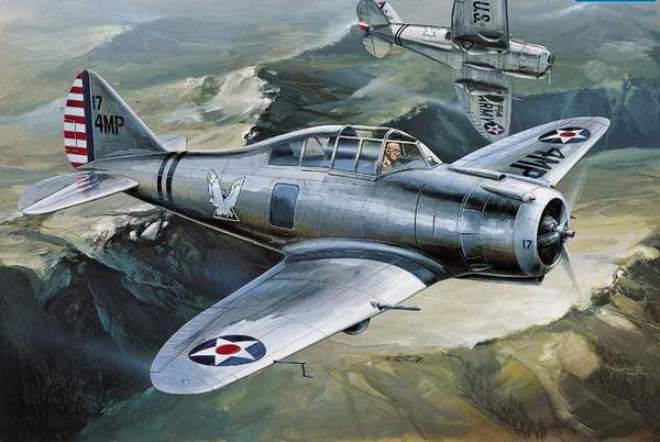
American aviation Seversky Aircraft Corporation was founded by Alexander Nikolayevich Prokofiev-Seversky, who was born in Russia in 1894. During the First World War, Seversky was an officer in the Russian army and became the third most victorious domestic ace - he accounted for 13 enemy aircraft shot down. By the time of the October Revolution, he was the Russian Air Force Attache in the United States, where he decided to stay. Seversky later received American citizenship and became a major reserve army army corps.
In 1931, Major Alexander Prokofiev-Seversky and a group of investors organized the Seversky Aircraft Corporation in Farmingdale, Long Island. The chief engineer of the company was Alexander Kartveli, also an emigrant from Russia.
The first aircraft of the company was the SEV-3 - an all-metal amphibian with a cantilever wing. "Troika" meant the number of crew members. The aircraft was built in a hangar, leased from the "Edo Aircraft Corporation" - a well-known manufacturer of seaplanes.
The first SEV-3 was circled in June 1933. Colombia ordered six vehicles that were used as scouts. To ensure the amphibiousness of the aircraft had retractable wheels in the chassis floats. 15 September 1935 of the year on the first copy of the SEV-3 was achieved speed 369,8 km / h, which still remains a record for amphibians with a piston engine.
The two-seater ground version of the aircraft with dual control was supplied from 1935 to the Army Air Corps, which received 8 aircraft under the designation AT-30. This aircraft was the first all-metal training low-wing aircraft that entered service with the army, and at the most opportune time - fighters and biplane reconnaissance aircraft were being removed from service. It was also the army's first dedicated training aircraft, not a combat vehicle conversion. The AT-8 was powered by a Pratt & Whitney Wasp-Junior engine with 450 hp and a top speed of 280 km / h.
In 1935, Seversky started the initiative development of an experimental fighter under the designation SEV-2ХD, which meant "Seversky - a double, experimental, demonstration". The SEV-2XD was equipped with an Wright R-1820 air-cooled engine rated at 850 hp, with a three-bladed propeller, an elliptical wing, and the undercarriage was non-retractable with large wheel fairings. In May, under the designation SEV-2XP (P-fighter), the aircraft was submitted to the competition of the Army Air Corps to replace the Boeing P-26 fighter.
A new version of the SEV-2XP was ready in the spring 1935 of the year. However, Major Seversky found out that his competitors - Curtiss ("75" model) and Northrop-3A - are equipped with retractable landing gear, and 18 on June 1935goda SEV-2XP was "heavily damaged" during the flight to Wright Field, where the competition was to take place trials. After which the aircraft was sent back to the factory in Farmingdale for "recovery." Some "cynics" suggested that Seversky had tweaked the "incident" in order to gain time to rework the plane.
Participation of the Seversky company in the competition was suspended, but the chances of the converted SEV-2XP increased. Twin aircraft became single and got retractable landing gear. The wheels of the main landing gear were partially covered with streamlined panels and remained in the stream, after cleaning the struts back to the fairings under the wing. The tail wheel was also made retractable, and the single cabin was closed with a lantern. On the plane put a new modification of the Wright R-1820-65 "Cyclone" engine with HP 850 power. The corporate designation of the aircraft has changed to SEV-1ХР, where "1" already denoted a single-seat aircraft. The armament was to consist of two 7,62-mm synchronous machine guns.
The converted SEV-1XP finally arrived at Wright Field 15 August 1935. The appearance at the very end of the competition a completely new competitor was greeted by other companies without enthusiasm. Meanwhile, the Army Air Corps extended the competition to April 1936, as another contestant Northrop-3A in July, 1935-th fell into the sea during the first test flight.
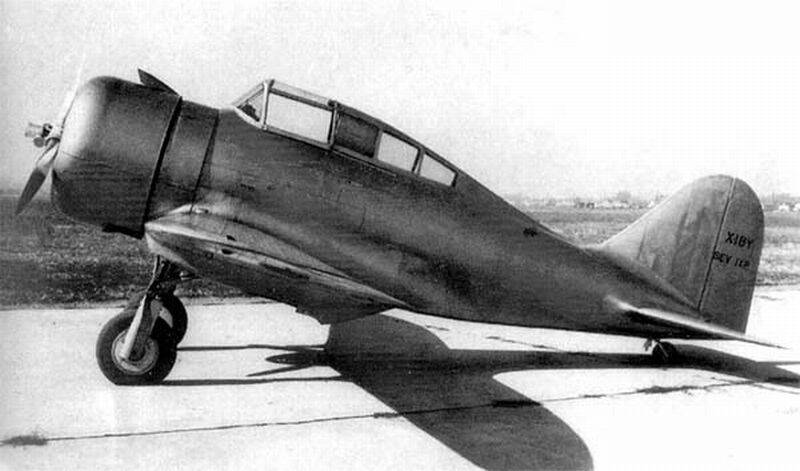
During tests at Wright Field, the SEV-1XP at an altitude of 3050 showed a speed of 462 km / h, which was below the expected 480 km / h. The extension of the competition allowed Seversky to modify the aircraft. The main reason for the lack of speed was the unreliable operation of the Cyclone engine, which was replaced by the Pratt & Whitney R-1830-9 Twin Wasp with an output of 850 hp. With the new engine, the aircraft received the designation SEV-7. At the same time, the vertical tail was redone. However, "Twin Wasp" actually produced only 738 hp, as a result, the speed of the fighter even dropped to 443 km / h.
Meanwhile, Curtiss put on the "75 model" a new Wright XR-1820-39 air-cooled engine. At the same time, Vout acquired the 3A from Northrop and introduced a new version of this fighter under its brand name V-141. Consolidated with its single-seat version PB-2А also joined the competition. After additional modifications, SEV-7 changed its designation to AP-1. Although the Seversky fighter did not reach the promised 480 km / h, however, he was recognized by the army as the winner of the competition, and 16 June 1 936 of the year Seversky signed a contract for 77 fighters, designated P-35.
The P-35 strongly resembled the SEV-7 with its cantilever wing. The wing had an all-metal structure with a fabric sheathing. The engine was a Pratt & Whitney R-1830-9 with 850 hp, closed by an aerodynamically clean hood. The armament met American standards of those days: one 12,7-mm and one 7,62-mm synchronous machine guns, which was then clearly not enough. In particular, the Hawker "Harikkein" that appeared at about the same time had eight 7,62-mm machine guns.
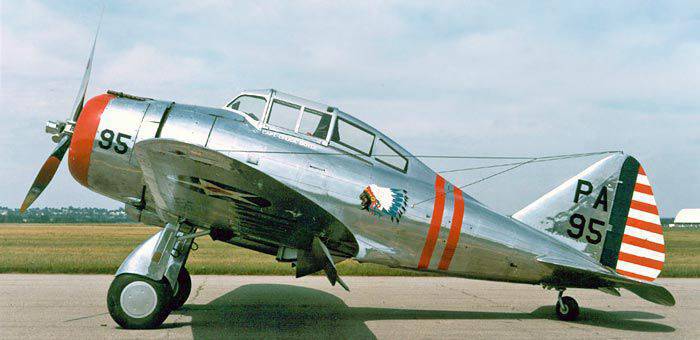
The deliveries of the P-35 to the Army Air Corps began in July 1937, but were slow: the 1-I fighter group (17-I, 27-i and 94-I squadron) was re-armed only by the spring of 1938-th. Such unhurried work of Seversky’s company and the constant disruption of supply plans caused the army’s patience to fail, and it decided not to extend the contract for the supply of fighters, and 30 on July 1937, the army ordered 210 fighters Curtiss P-36 - the production version of the “75 model”, ranked second in the 1936 competition.
The last ordered P-35 was delivered in August 1938. After several months of operation, the X-NUMX fighter group P-1 were distributed among the 35, 31, 49, 50 and 53 groups that were awaiting rearmament on the P-58.
Success with the creation of the P-35 prompted the airline to begin developing an export version of the aircraft. On the basis of the P-35, the Seversky corporation developed a double export fighter, designated 2PA-L. The aircraft was equipped with an X-NUMX-powerful Wright R-1000 engine. The only 1820RA-L built was sold to the Soviet Union in March 2. At the same time, a version of a hydraulic builder based on the 1938PA-L was purchased, but under the Wright engine R-2-С1820 with an 2 power hp and a license for its mass production. However, due to the identified deficiencies of the propeller group, weapons, low structural strength and low combat survivability, there were no real attempts to organize the mass production of 850PA-L in the USSR.
Twenty two-seat fighters on the model 2PA-L were sold to Japan. The brand name of these machines was 2RA-VZ, and in Japanese navy they bore the designation "double fighter marine type 5" or in short - A8V1. The Japanese used them in China, but by the time the war in the Pacific began, they were no longer in service.
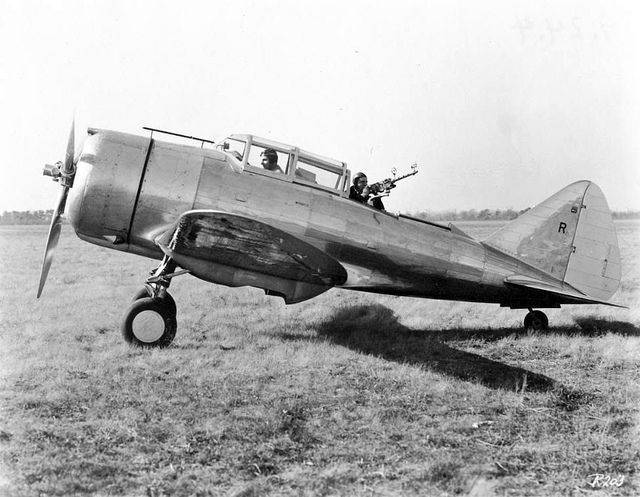
Seversky, seen in "vicious" relations with Japan, became an outcast in official circles of the USA, and the army decided to stop purchasing Р-35 from his company. Seversky was always more a pilot than a merchant, and by the beginning of 1939, his company was in a deep debt pit. In April, 1939, while Seversky was on a business trip, the board of directors officially made a decision about his resignation, and the name of the company was changed to Republic. After the revision of the authorized capital, Alexander Kartveli became the company's vice president and technical director. Seversky, who was early retired, spent the rest of his life writing memoirs and conducting individual consultations, and Kartveli and Ripablik later became famous after the release of the legendary P-47 Thunderbolt.
The last ordered P-35 was supplied in 1938, under the designation XP-41, and was distinguished by the installation of an R-1830-19 engine with an 1200 horsepower, equipped with a turbocharger. The first flight of this aircraft took place in March of 1939, shortly before the change of the company's name. The maximum speed at the height of 4575 m reached 517 km / h, but the army preferred to be created in parallel with the AP-4, later designated YP-43, and work on the XP-41 was discontinued.
By 1940, the rapid development of fighter aircraft made the P-35 obsolete. He had already too low speed, was poorly armed, he was missing a reservation and protected tanks. As a result, the service career of the P-35 was short. By the beginning of 1941, most of the P-35 had been removed from service on the first-line parts and replaced with the Bell P-39 Aero Cobra or Curtiss P-40. As the P-35 was removed from the armament of the combat units, they were transferred to the training units and technical staff schools. By the time of the attack on Pearl Harbor, there were practically no such vehicles in service with the army.
After the cessation of deliveries of the Seversky fighter, the army could only hope for export orders. Soon, the Seversky company began to actively look for foreign markets for its aircraft, the export version of which received the firm designation EP-1. June 29 1939 - two months after Seversky’s resignation - Ripablik already signed a contract to supply the Swedish government with 15 fighters of this model.
The Swedish government later expanded the contract to 120 aircraft. By June 1940, the Swedes received an 60 EP-1. In the Royal Swedish Air Force, they wore the designation J-9. However, in June, the United States government imposed an embargo on the shipment of weapons to any country, with the exception of Great Britain, and deliveries to Sweden ceased.
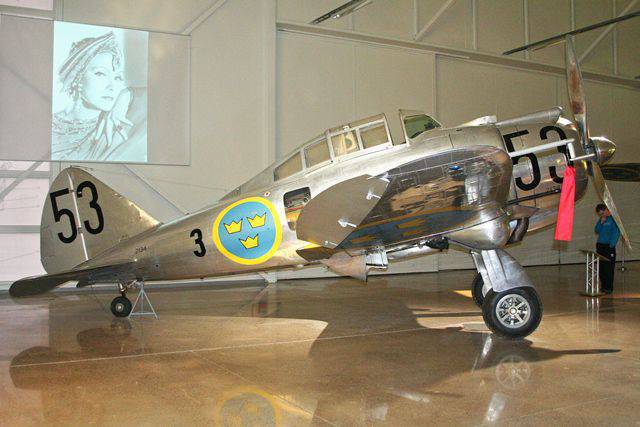
Despite the embargo, Ripablik continued production of EP-1 aircraft were simply stored in the company’s territory. 24 October 1940 Mr. President Roosevelt signed an order for the purchase of all remaining EP-1 fighters in the States for delivery to the Army Air Corps. Aircraft received the designation P-35A. Also 50 twin-seat 2PA fighters ordered by the Swedes were purchased. The US Army did not see any practical combat value in the double version of EP-1, and it was decided to use them as training machines. The aircraft were renamed AT-12 "Gvardsen".
Several P-35A were sold to the Ecuadorian Air Force, but most of them — 40 fighters — were sent to the Philippines in 1941 of the year. They entered service with the 34 and 21 of the Fighter Squadrons as part of the 4 of the mixed air group at the airfield in Luzon.
8 December 1941 g, when the Japanese started the bombing of the Philippines, the Р-35А fighters made up a significant part of aviation in the archipelago, but their real combat capability was low - for the end of 1941. P-35A were hopelessly outdated. As a result, in air battles against the Japanese “Zero” P-35A suffered heavy losses. Most of the P-35A were soon lost in aerial combat and on the ground. By December 12 there were only eight flight Р-35А.
The remaining X-NUMXA P-35s in the United States in October were renamed RP-1942, which marked the end of their combat career. EP-35 fighters remained in service with the Swedish Air Force until 1. One P-1944 was displayed at the Wright-Patterson Air Force Base Museum in Daytona, Ohio.
Although the P-35 did not have an advanced design, it served as a model for several fighter projects. In the famous Italian aviation company Caproni-Reggian, on the basis of the P-35, the Reggiane 2000 fighter was created. The conducted test flights revealed its superiority over Bf.109 and Hawker Hurricane. This aroused interest in many European states, including Great Britain and Yugoslavia. But the plane did not get into the Italian Air Force. At the same time, Reggiane 2000 found its place in the Swedish and Hungarian Air Forces, which bought the production license. It should be noted that the Hungarian fighters were used during the Second World War on the Eastern Front.
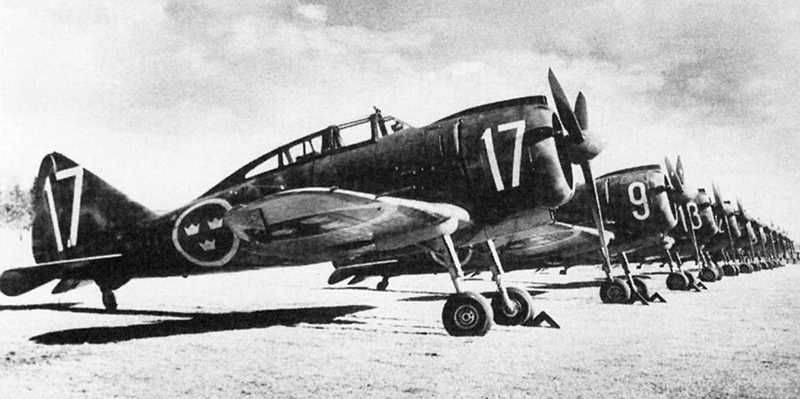
Р-35 as a basis for its project PZL P-50 Jastrzab (Hawk) was also used by the Polish designer V. Yakimuk. The aircraft was supposed to replace the outdated PZL P-11 fighter jets and was equipped with the British 840-strong star-powered Bristol Mercury VIII engine. By the beginning of World War II, the first fighters were in the assembly stage. And the only prototype that flew was mistakenly shot down by Polish anti-aircraft artillery in the Lviv region.
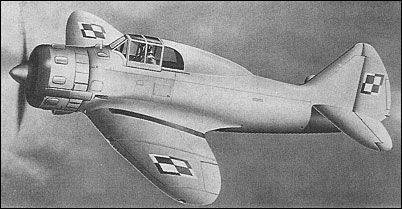
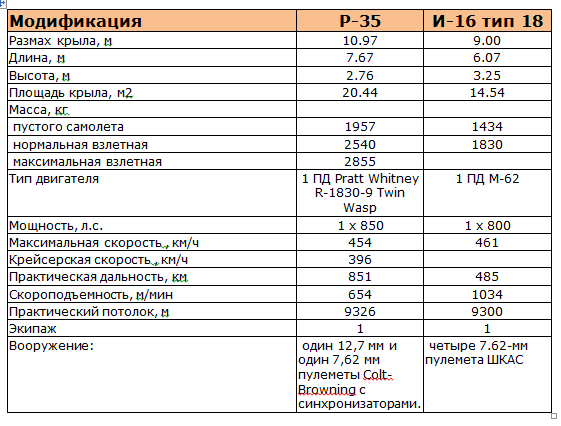
Sources:
Anceliovich L. Russian Wings of America. "Thunderbolts" Seversky and Kartveli M .: Yauza, 2015. C. 109-117.
Dmitry Sobolev D. "Seversky" against I-16 // Wings of the Motherland. 1997. No.2. C. 22-23.
Kotelnikov V. Unsuccessful purchase // Avio. No.6. C. 30-32.
Firsov A. US Fighters // Aviation Collection. No.13. C. 36-38.
Sobolev D. Free Wing // Wings of the Motherland. 1993. No.10. C.12-15.
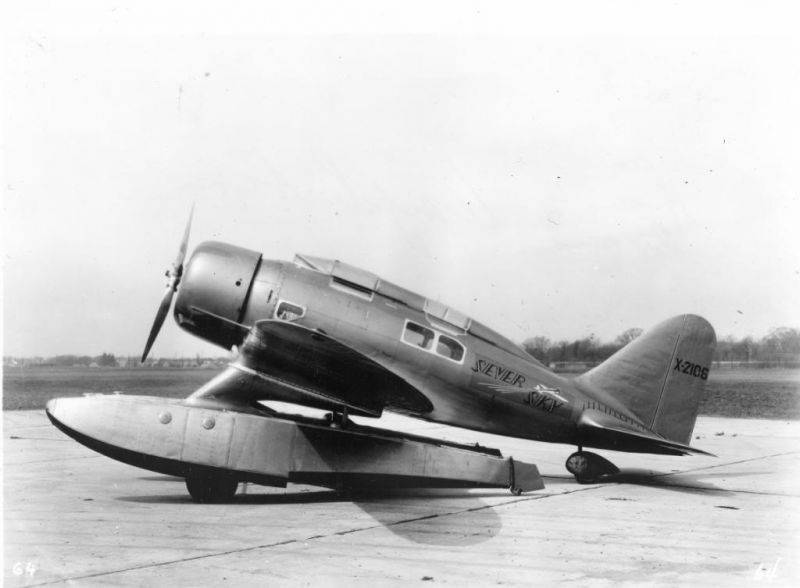
Information